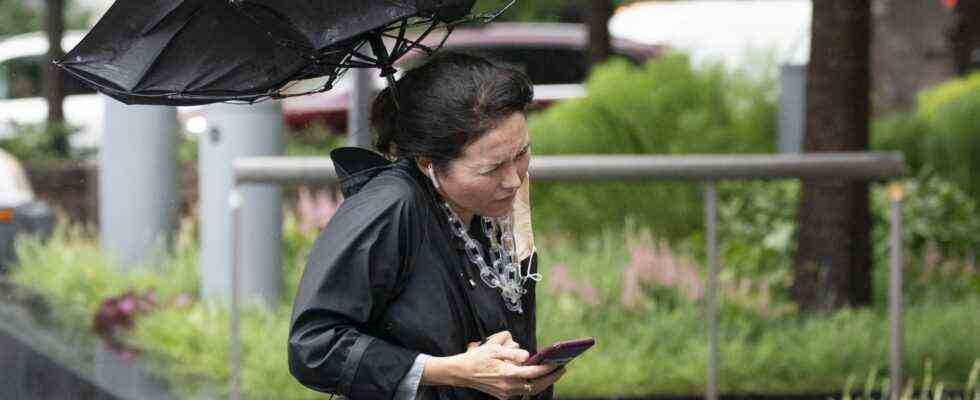Status: 07/21/2021 10:14 a.m.
What is still being discussed in Germany has long been a practice in New York: the automatic warning of severe storms via SMS. The procedure works precisely to the street and without storing the location data.
In front of Rebecca Baudendistel is a digital map showing all the districts of New York. The head of the authority for public warnings can select with a click of the mouse which areas should be informed – precisely down to individual streets. Health, storm or amok alarm – Baudendistel can spread all of this with a message with a maximum of 360 characters. “It is our job to inform people so that they can make life-saving decisions,” says Baudendistel.
Among other things, so-called Wireless Emergency Alerts (WEA) are sent out in their authority, i.e. emergency alarm messages on cell phones. Most recently, at the end of June, an urgent heat alarm was sent to all New York residents. It called on all households to stop using washing machines and microwaves in order to save energy and prevent a power failure. According to the head of the authorities, electricity consumption fell across the city within minutes.
From this headquarters in New York, the warning is sent to the citizens of the city – automatically and precisely to the location.
Image: Marc Steinhäuser / ARD-Studio N
No storage of location data
This system has existed in the United States since 2012 – the national weather service and security authorities can also operate with it. There is also a separate warning category for the US president. All cell phone owners in a region then receive an automatic emergency warning with a special alarm tone via their cell phone provider. This works independently of an app, without registration, and above all: without storing location data. For citizens it looks like an SMS, the text message reports like an SMS with an alarm, but technically there is a kind of fast lane in the cellular network for this emergency alarm.
Baudendel, for example, does not send their reports to telephone numbers – they do not even have them. It forwards the alarm to the local telephone providers and to the residents via their radio masts. “It doesn’t matter what telephone contract someone has, the alarm is issued by all providers,” she explains. In the USA, the major telecommunications providers such as T-Mobile, AT&T and Verizon had volunteered to do this.
SMS warnings work quickly, says Rebecca Baudendistel, head of the New York headquarters.
Image: Marc Steinhaeuser / ARD-Studio New
Significant investment required
After the dramatic floods in North Rhine-Westphalia and Rhineland-Palatinate, there is a discussion about how this so-called cell broadcasting could be introduced in Germany. Support for such plans came from Federal Transport Minister Andreas Scheuer and NRW Prime Minister Armin Laschet, among others. However, this SMS system has not yet been offered in Germany.
The Federal Office for Civil Protection and Disaster Assistance (BBK) is now having the introduction checked in a feasibility study by autumn of this year. The start-up investments would, however, be estimated at 20 to 40 million euros. The system was not cheap in the USA either: the US Congress had contributed more than 100 million dollars.
Just part of the toolbox
All you have to do is click a few clicks in the crisis center so that every citizen is warned by SMS. Thistle describes the cell phone alarm system as part of a tool kit. Sirens could also be part of it. “In emergencies, you simply have to exhaust all possibilities in order to reach people in as many ways as possible.”
The city of New York has already experienced a number of disasters: the terrorist attacks of September 11, 2001, extreme snowfalls, hurricane Sandy – or even the gas explosion in residential buildings. The city has learned from these events, says Baudendistel, head of the authorities. “Crisis communication doesn’t end with an emergency.”
After that, further information would be needed, for example to bring families back together. Only one thing shouldn’t be done: send too many reports – then the population would no longer take the warnings seriously enough.
Disaster warning by SMS: possible in New York for a long time
Carsten Schabosky, ARD New York, July 21, 2021 10:53 am

